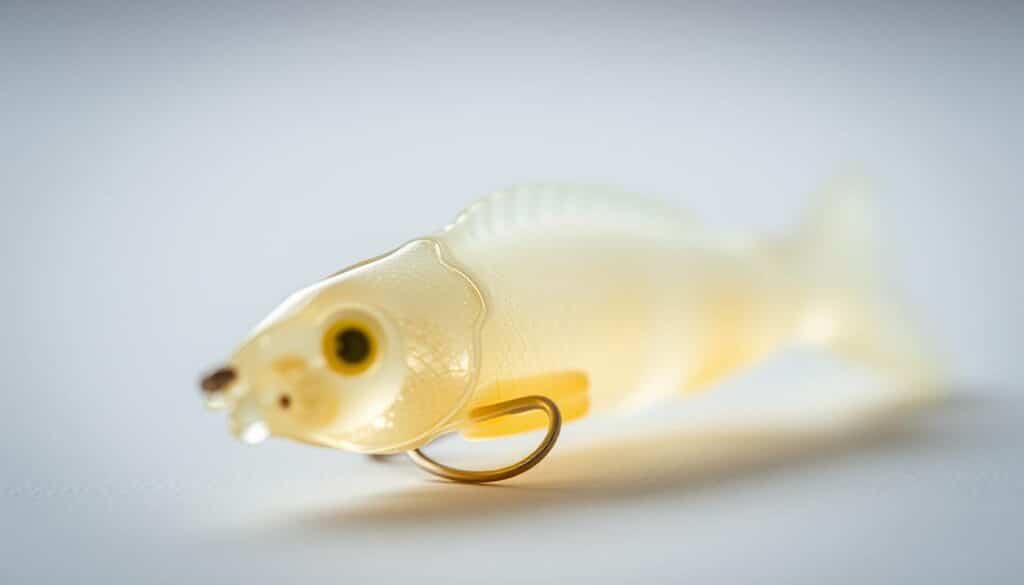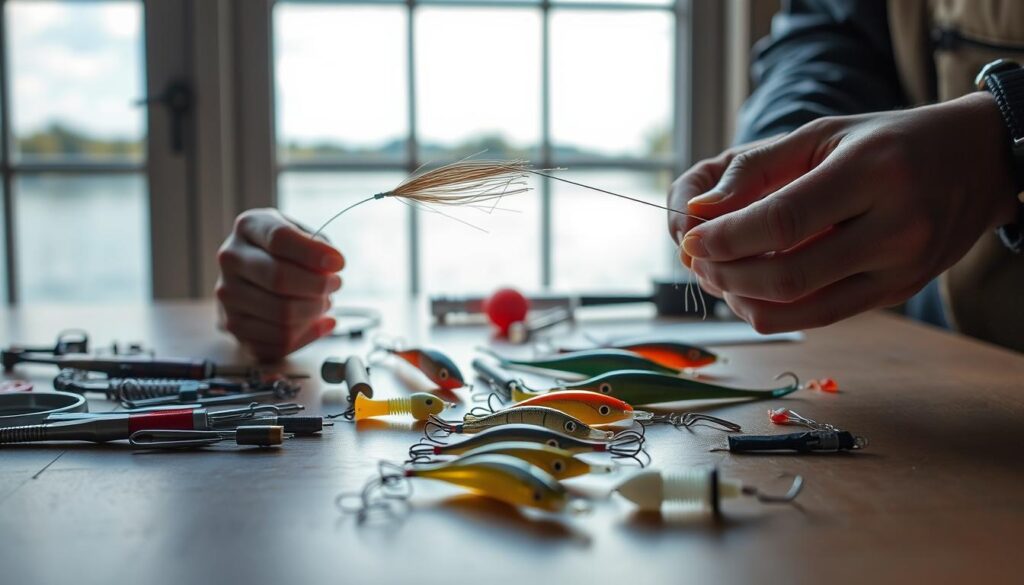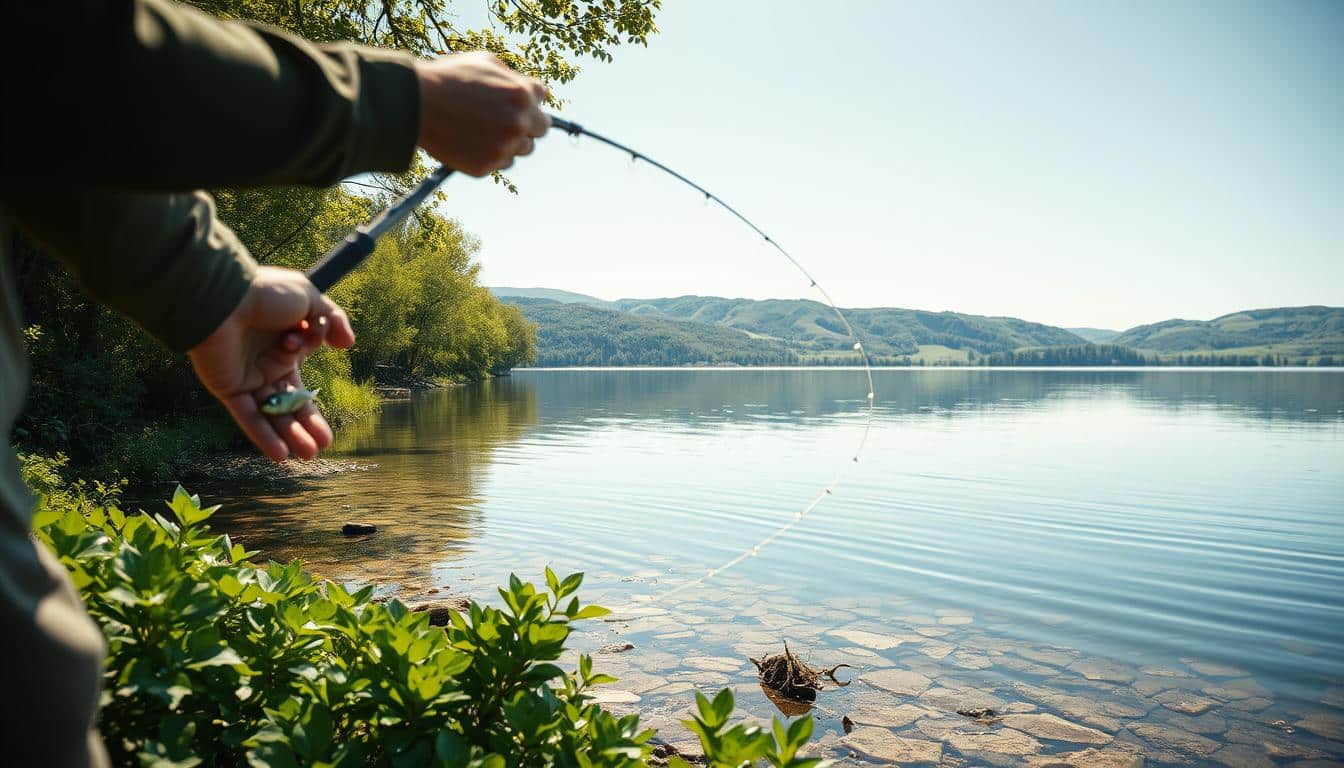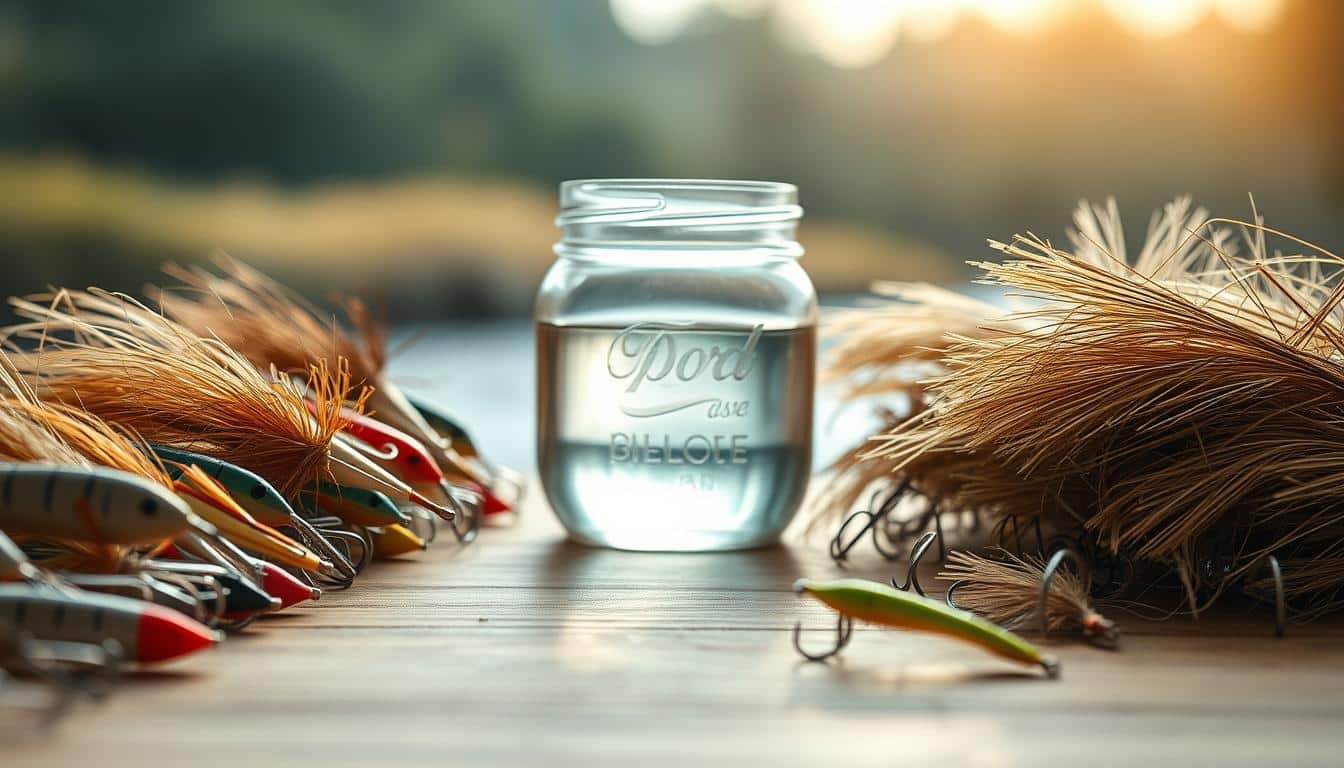Moving from PVC soft plastics to biodegradable fishing baits is simple for anglers. Since the 1950s, plastisol soft baits have been top choices, leaving millions of pounds of trash in our waters. By choosing sustainable lures, you help keep our lakes and rivers clean, protecting fish like bass and trout.
There are many eco-friendly lure options, from homemade gelatin recipes to commercial biopolymers. You can make your own with gelatin, water, and a bit of fish oil or food coloring. After heating, pour it into molds to make biodegradable lures. These lures attract fish well but need to be kept cool and handled with care.
Our guide helps you move to eco-friendly lures, looking at durability and cost. It offers easy steps to start this journey. Whether you try edible baits or test out commercial ones, the aim is to fish responsibly. Doing so cuts down on waste and helps keep our fisheries healthy for years to come.
Why anglers should consider eco-friendly lures for sustainable fishing
Anglers who value clean water and healthy fish should think about using eco-friendly lures. Traditional soft plastics are popular but harm lakes, rivers, and coasts. By choosing different tackle, we can decrease trash and harmful substances in our waters.
Environmental impact of PVC soft plastics
PVC-based plastisol baits are tough on the environment. They’re made of polyvinyl chloride and plasticizers that don’t break down easily. When they fragment, fish might eat them, causing debris and harmful particles to spread through ecosystems.
Making PVC baits can release dangerous fumes, posing risks to humans. Yet, there’s hope with gelatin lures. These alternatives decompose and won’t pollute like PVC, making fishing more sustainable.
Scale of the problem in U.S. recreational fishing
The U.S. loves its recreational fishing, supporting a big demand for soft plastics. Millions of anglers use and lose soft baits yearly. Each angler might lose several pounds of PVC lures, due to various reasons.
All these lost lures add up, leading to a lot of plastic waste from fishing. This pollution mainly comes from accidental losses, not dumping. Switching gear is a straightforward way to address this issue.
Benefits to fish, waterways, and angling reputation
Switching to non-PVC lures helps our aquatic friends and their homes. Biodegradable lures lessen the risk of fish ingesting plastic. They also reduce microplastic pollution in sediment and plants.
Outreach by local groups can promote eco-friendly fishing. Tackle shops and organizations like Trout Unlimited can share the perks of biodegradable lures and tips on handling them. This improves how people see anglers as protectors of nature.
Choosing eco-smart tackle lowers the impact of fishing on the environment. Anglers focused on reducing PVC’s effects make fishing better for everyone. Making the switch shows we care about our waters and the sport’s future.
Overview of eco-friendly lure materials and alternatives
Anglers looking for alternatives to PVC soft plastics have several options. These range from lab-created biopolymers to simple recipes you can make at home. Each material offers a balance of usability, durability, and environmental friendliness.
Biopolymers and compostable materials as PVC replacements
Biopolymer fishing lures are being developed to feel like plastisol but break down naturally. They aim for heat resistance, strength for fishing, and easy molding capabilities.
Some baits now use compostable materials that biodegrade quickly without leaving microplastics behind. These materials are processed at low temperatures, allowing DIY enthusiasts to shape their lures using 3D printers or silicone molds.
- Design goals: durability, biodegradability, and manufacturability for scale.
- Benefits: easier recycling at end of life and reduced pollution in fisheries.
Gelatin-based and edible lure options
Gelatin-based baits mix edible gelatin, water, and fish oil for scent. They become firm in the fridge, creating life-like worms and grubs. Fishermen prefer these for their natural scent and ability to compost.
DIYers favor gelatin baits because they’re safer to make than plastisol ones. These mixtures are easy to adjust for the perfect texture and smell, making them ideal for home bait crafting.
Other natural or biodegradable ingredients used by hobbyists and manufacturers
Anglers are also trying out biodegradable ingredients like plant glycerin, starches, and safe polymers. These materials can make lures more elastic and longer-lasting without harmful plastics.
Manufacturers are testing new blends, learning from the prosthetic and special effects industries. They share updates through newsletters, guiding anglers on where to find eco-friendly bait materials or pre-made lures.
How to Switch from Plastic to Eco-Friendly Lures
Switching from traditional plastic to eco-friendly lures requires setting clear, realistic goals. Consider lure life versus its tendency to break down, how much it costs, and ease of use outdoors. These factors help decide if a gelatin-based, biopolymer, or a mix of both is the best fit for your fishing needs and budget.
Setting goals: durability, biodegradability, cost, and handling
Start with this rule: aim for at least one catch for each lure used. If you fish in the summer, pick lures that won’t melt in your tackle box. Also, think about how easy they are to make or process. Methods requiring low heat make it safe to create them at home.
Talking about costs, balance the price of each bait against how long it lasts. Gelatin lures don’t cost much and work great with fish oil for scent. They’re good for catching smaller fish but might not last beyond one use in hot weather. Keeping them cool and safely packed ensures they remain useful.
Choosing the right eco-friendly lure type for your fishery and target species
Choose materials based on the fish you’re targeting and the water conditions. Gelatin or edible materials work well for smaller freshwater fish. But, for larger or sharper-toothed fish, consider newer biopolymers. Some brands now test compostable soft baits that fit these needs better.
When picking an eco-friendly bait, make sure it works with your existing fishing gear. Look for those that let you embed hooks when making the bait or support various rigs. This reduces the bait tearing when you pull it back.
Trial and error: testing lures in local waters and recording results
Plan small tests before completely switching over. Use these biodegradable lures on a few fishing trips. Change how you present them and the way you rig them up. Then, record your catches, any damage to the lure, and water temperatures. Keep a short checklist to stay consistent with your records.
- Record species caught, how often you get bites, and the condition of the lure after use.
- Make a note of any steps you took to make the lures last longer, like keeping them cool.
- Compare how long the lures last against how quickly they break down. This helps you figure out if their lower cost is worth it.
Create a feedback circle within your local fishing community. Share your findings via club emails or newsletters. Invite fellow anglers to test the same lures. Gathering data from various waters helps learn faster. It aids in picking the best eco-friendly bait for the area’s waters.
Home recipes and DIY biodegradable lure methods
Making your own soft baits helps save money and reduces waste. You can control their scent and texture. These methods use gelatin recipes and simple tools found in your kitchen. They are based on safe, low-heat techniques from the film and makeup industries. This means they work well with low-temperature molds and 3D-printed shapes. These steps are perfect for creating eco-friendly fishing lures and tasty baits for many fish species.

Basic gelatin recipe
- 4 packets unflavored gelatin (about 28 g)
- 3/4 cup water (180 ml)
- Optional: a few drops food coloring and fish oil for extra scent
Step-by-step home method
- Start by pouring 3/4 cup water into a small pot. If adding scent, mix in fish oil now.
- Then sprinkle the gelatin on top of the water and wait a minute.
- Gently heat it on the lowest setting, stirring until fully liquid. Avoid boiling to keep the gel stable.
- Next, add any dye, stir well, and pour into molds.
- Freeze for 15 minutes, then wrap and refrigerate.
Simple mold-making with straws and containers
Take some drinking straws, cut them in half, and tie them together. Stand them up in a container with their cut ends up. Pour the gelatin into the straws to make worm shapes. Remember, larger molds take longer to set, so use small amounts for quick results.
Hook-setting tip
To make them more durable, put a hook in the straw before pouring in the gelatin. This way, the hook sets inside the bait as it cools. It’s stronger than adding hooks after the bait is made.
Notes on safety and iteration
Gelatin is safe to use at low temperatures, unlike some plastics. This makes it great for use with delicate molds. Keep track of what works, including scents and colors, and your catch success. Sharing your experiments with a local fishing group or newsletter can help improve your homemade baits.
Pros and cons of homemade biodegradable lures
Homemade biodegradable lures are a step towards ditching PVC plastics. Anglers like that they are cheap, easy to scent with fish oil, and quickly attract fish like bluegill. Making small batches lets you try out different colors and scents cheaply.
However, there are downsides to these lures. When fishing, the differences between homemade and store-bought baits become clear. They decompose naturally, cutting down on plastic trash, but they don’t always act like their commercial counterparts.
Advantages
- Making them is cost-effective, so you can create lots of baits.
- Adding scents improves your chances of getting fish to bite.
- They are easy to make with things you have in your kitchen.
- They break down naturally, reducing pollution in waterways.
Limitations
- Some shapes only last for one use before falling apart.
- They can melt or get mushy in hot weather.
- They often tear easier than traditional baits when fish bite.
- Without chilling, they can lose their shape quickly.
To overcome these issues, anglers share tips through clubs and newsletters. Small changes in how you rig and store them can make them last longer when fishing.
Practical tips to mitigate cons
- Place hooks in the baits as they set to keep them on better during casts or when catching fish.
- Freeze your baits until firm for transporting, and keep them in a cool box until you use them.
- Use hooks on front and back or weedless setups to cut down on tears when fish strike.
- Try out small amounts in local waters, note what works, and adjust to find the right mix of lasting and biodegradable qualities.
Biopolymers made by companies are getting better at resisting heat and lasting longer, improving upon some homemade bait issues. For now, mixing the benefits of gelatin baits with clever rigging and cooling provides a good, budget-friendly option while we wait for advancements.
Commercial eco-friendly lures and biopolymer developments
The sustainable tackle market is rapidly growing. Anglers now have more options besides homemade alternatives. Brands are rolling out biodegradable fishing lures and biopolymer soft baits. They aim to be as good as traditional ones but better for the environment.
Researchers are exploring biopolymers as an alternative to plastisol. They’re focusing on materials that degrade in water and are wildlife-safe. They also need to endure casting and retrieval. The aim is to find a balance between eco-friendliness and practical use.
-
R&D is looking into making baits compostable, water-degradable, and manufactured safely.
-
They need materials that work well with both industry and hobbyist equipment.
-
Keeping costs low is crucial for stocking biodegradable fishing lures competitively.
Overview of emerging biopolymers
New formulas include starches, PLA, and proteins for stronger biopolymer baits. Studies focus on their shelf life, reaction to sun and heat, and scent holding. We’re seeing slow but steady enhancements.
What to look for when buying biodegradable or edible soft baits
Before buying, check the labels for compostability, how fast they break down in water, and if fish can eat them. Choose brands that share test results. This transparency is helpful.
-
Look into how resistant they are to tearing and how many casts they last.
-
Find out if these biopolymer baits need to be stored cooler than PVC ones.
-
Make sure the lures fit standard fishing setups without extra work.
Durability and storage improvements to expect from commercial offerings
Edible lures are getting tougher and last longer without going bad. Improved heat resistance and durability are key for summer fishing. These features make the baits worth using multiple times.
Manufacturers and retailers share news and tips in newsletters. Subscribing can tell you about new products and how to store and use them. This makes trying out biodegradable baits simpler.
Safe manufacturing and handling practices for hobbyists
Making lures at home is easy and safe if you follow some basic steps. Keep your work area clean. Use gentle heat for mixing and keep your baits in a cool, dry place after they’re made. Use clear labels and a checklist to avoid mistakes when making baits safely.
Why gelatin methods are lower-risk than molten plastics
Gelatin recipes need low heat and just a gentle warm-up for around two minutes. This avoids the high heat needed for plastics. Gelatin is safer than plastisol because it doesn’t give off harmful fumes. You can even use normal kitchen tools with it, as long as you keep things food-safe.
Heat, storage, and transport best practices
- Use a dedicated pot and utensils for bait mixing to avoid food cross-contamination.
- Set gelatin molds briefly in the freezer for about 15 minutes to speed setting, then chill in the refrigerator until use.
- For homemade lure storage, wrap pieces in paper towel and place them in sealed containers or resealable bags to prevent sticking and odor transfer.
- When transporting lures, keep them in a cooler or insulated bag to avoid heat softening on warm days.
Working safely with low-temperature and 3D-printed molds
Low-temperature molds are safer than those needing high heat. They protect tools and work well with 3D-printed molds. Make sure to use heat-resistant materials like PETG or nylon for your 3D molds. Always test a small amount first.
Here are some tips to stay safe: wear gloves for warm mixtures, keep air moving in your work area, and spread the word. Sharing safety checklists in clubs or newsletters helps everyone make and store their lures safely.
Rigging, storage, and field-use tips for eco-friendly lures
Eco-friendly soft baits need careful handling to perform well and last through a day on the water. Simple rigging and storage steps can help. They reduce tearing, keep the texture firm, and lower discarded pieces.
Following these practices makes gelatin lures last longer. They will survive rigging, casting, and even a hard bite.

Embedding hooks when casting
- When the mix is warm, set a hook shaft into the mold. As the bait cures, the hook embeds, reducing splitting.
- Use a short-shank hook near the head. Add a small rear hook or stinger to prevent tearing on a long run.
- Choose 3D-printed molds at low temperatures or silicone forms. Look for reinforced anchor zones. This improves strength where it’s needed most.
Chill, wrap, and carry
- Chill lures before use. A short time in the fridge makes gelatin baits firmer, easier to rig. For long trips, pack them in an insulated cooler or a small Pelican case with frozen packs.
- Wrap individual lures in paper towel or wax paper. This absorbs moisture and stops sticking. Keep them flat to avoid changing their shape.
- If you’re using biodegradable lures outdoors, plan for the heat. Choose mixes or commercial biopolymers that handle warmth better, reducing waste.
Maximizing one-cast effectiveness
- Understand that many homemade gelatin rigs are good for one catch. To hook more fish, use scents like fish oil, size your bait right, and set the hook quickly.
- Choose the right bait for the fish and area you’re aiming at. Shorter casts help manage soft tails and lessen splash.
- After a bite, gently remove the lure and fix tears quickly. Small rips can be fixed by pressing the pieces together and chilling them.
Field habits that reduce lure waste
- Carry extra hooks, fine pliers, and a chilled pack for quick changes. This helps avoid throwing away lightly damaged baits.
- Share tips with local fishing clubs or lure makers. Community advice on keeping biodegradable baits usable leads to improvements that lower waste.
- Choose baits that can handle a bit of heat or are made of mixed biopolymers for many casts. This reduces trash and makes lures last longer.
Testing, documenting results, and improving lure recipes
Field work makes our biodegradable baits better. Start small: small batches, clear notes, repeatable steps. This lets us test lures under real conditions. Keep your records tidy and consistent. Always use the same rod, line, and casting method.
Before going out, set a simple plan. Standardize how many times you cast, how fast, and how you pull the lure back. Record the water’s temperature, how clear it is, the wind, and the time. Test plastisol next to eco-friendly versions to see the differences.
- Standard casts per lure: 20–30 per session.
- Consistent presentation: same retrieve cadence every trial.
- Environmental notes: temp, clarity, cover type.
Look at what fishermen care about. Track how many fish each lure catches, bites per lure, and casts till a lure breaks. Notice if hooks tear the lures or if the scent goes away fast. Use a log sheet or an app to track how each lure does on each trip.
- Record species and number of catches.
- Log durability: casts before failure and bites until breakage.
- Note environmental observations like lost lures and visible biodegradation.
Tweak your recipes after testing. Change one thing at a time – like gelatin amount, binder, or smell strength. This shows clear effects. Label each version clearly to keep results neat. Aim to make your DIY lures better by enhancing how they handle heat, their feel, and how long they smell.
Try smart rigging tips in your trials. Put hooks in molds, use various hook sizes, and cool lures to lessen tears. This helps compare how they really work. It also lets you improve your formulas quicker while testing them out fishing.
Get more feedback to make your findings stronger. Invite local fishers, send out emails, or share test kits to get info from different places and seasons. Grouped results confirm adjustments and show which changes really make your DIY lures better on a big scale.
Keep your updates straightforward and test again regularly. A steady routine of testing, documenting, and tweaking recipes leads to constant improvement. This hands-on method helps make your home-made formulas trusted alternatives for fishing every day.
Conclusion
Shifting to gelatin-based and biopolymer options is a good move for anglers who care about clean waters and good fishing. By making gelatin baits at home, anglers can catch fish like bluegill just as well. Plus, they can tackle issues with bait durability by using simple tricks like embedding hooks into the molds, rigging baits properly, and keeping them cool.
The fishing industry is also working hard on finding compostable biopolymers that can take the heat and last as long as traditional plastisol, without polluting our waters. Soon, we might see eco-friendly lures that work for many types of fish and are easy to store. This shift towards sustainable options has to balance the need for products that are not only earth-friendly but also affordable and easy to make on a large scale.
Community efforts play a big role in making sustainable fishing a reality. By sharing bait recipes, safety advice, and testing results in clubs and online, anglers help each other learn faster. This community spirit helps everyone get better at using eco-friendly baits, making a big difference in how we fish sustainably.
FAQ
How do I switch from plastic to eco-friendly lures?
Why should anglers consider eco-friendly lures for sustainable fishing?
What is the environmental impact of PVC soft plastics?
How big is the problem in U.S. recreational fishing?
What benefits do eco-friendly lures provide to fish, waterways, and angling reputation?
What eco-friendly lure materials and alternatives exist?
What are biopolymers and compostable materials as PVC replacements?
How effective are gelatin-based and edible lure options?
What other natural or biodegradable ingredients do hobbyists and manufacturers use?
How should I set goals when switching from plastic to eco-friendly lures?
How do I choose the right eco-friendly lure type for my fishery and target species?
How should I run trials and record results when testing eco lures?
What is a practical gelatin recipe used by hobbyists?
What is the step-by-step home method for mixing, heating, dyeing, and pouring gelatin baits?
How can I make simple molds with straws and containers for worms and grubs?
What are the advantages of homemade biodegradable lures?
What limitations should I expect with homemade biodegradable lures?
What practical tips can mitigate the cons of homemade lures?
What emerging biopolymers are being developed to replace plastisol?
What should I look for when buying biodegradable or edible soft baits?
What durability and storage improvements can I expect from commercial offerings?
Why are gelatin-based methods safer than molten PVC/plastisol?
What are heat, storage, and transport best practices for homemade baits?
How do I use low-temperature molds and 3D-printed molds safely?
How should I rig gelatin and other soft biodegradable lures to reduce tearing?
What are proper chilling, wrapping, and carrying techniques to preserve lures?
How can I maximize one-cast effectiveness and reduce waste?
What simple field-testing protocols compare plastic vs. eco lures?
What data should I record about catches, lure longevity, and environmental observations?
How do I iterate on recipes for scent, texture, color, and durability?
How can community feedback and newsletters help improve eco-lure development?
Content created with the help of Artificial Intelligence.



